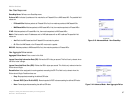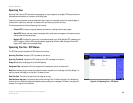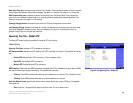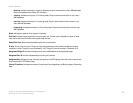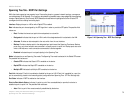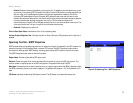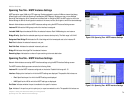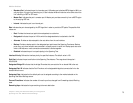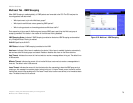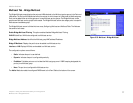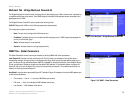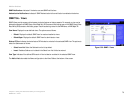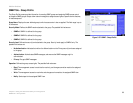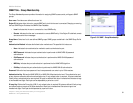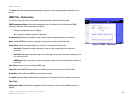
75
Chapter 5: Using the Web-based Utility for Configuration
Spanning Tree Tab - MSTP Interface Settings
WebView Switches
• Boundary Port. Indicates the port is a boundary port. A Boundary port attaches MST bridges to LAN in an
outlying region. If the port is a boundary port, it also indicates whether the device on the other side of the
link is working in RSTP or STP mode.
• Master Port. Indicates the port is a master port. A Master port provides connectivity from a MSTP region
to the outlying CIST root.
• Internal. Indicates the port is an internal port.
Role. Indicates the port role assigned by the STP algorithm in order to provide to STP paths. The possible field
values are:
• Root. Provides the lowest cost path to forward packets to root device.
• Designated. Indicates the port or LAG via which the designated device is attached to the LAN.
• Alternate. Provides an alternate path to the root device from the root interface.
• Backup. Provides a backup path to the designated port path toward the Spanning Tree leaves. Backup
ports occur only when two ports are connected in a loop by a point-to-point link. Backup ports also occur
when a LAN has two or more connections connected to a shared segment.
• Disabled. Indicates the port is not participating in the Spanning Tree.
Interface Priority. Defines the interface priority for specified instance. The default value is 128.
Path Cost. Indicates the port contribution to the Spanning Tree instance. The range should always be 1-
200,000,000.
Designated Bridge ID. Indicates that the bridge ID number that connects the link or shared LAN to the root.
Designated Port ID. Indicates that the Port ID number on the designated bridge that connects the link or the
shared LAN to the root.
Designated Cost. Indicates that the default path cost is assigned according to the method selected on the
Spanning Tree Global Settings screen.
Forward Transitions. Indicates the number of times the port has changed from Forwarding state to Blocking
state.
Remaining Hops. Indicates the hops remaining to the next destination.



